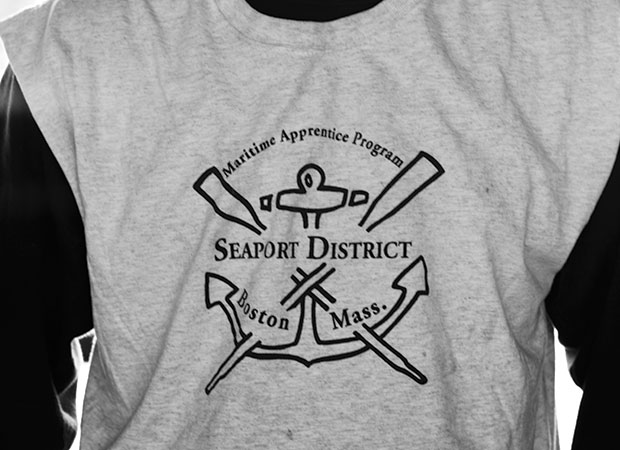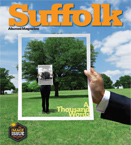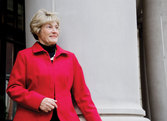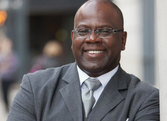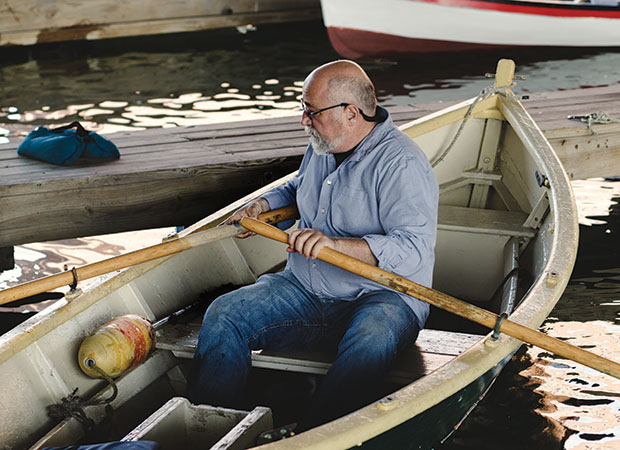
Anchor Man
For young men adrift in life Edmund Norton BS ’80, JD ’88 and his boat building program provide a mooring.
By Renée Graham
Sweet-faced but hard-edged, Richard wears his jeans low and his Kansas City baseball cap cocked just so. His delicate build makes him look younger than his 19 years, though he carries himself with the wary air of someone who has spent too much time watching his back. Ask him about the misguided actions that landed him in custody of the Massachusetts Department of Youth Services (DYS), the state agency assigned to handle troubled young people, and he’ll offer little more than vague allusions to drugs, mayhem, and a marginal existence that was rapidly devolving into another sad statistic of urban life. Yet when the subject turns to the 12-foot skiff behind him, which he helped build and will paint, name, and eventually row into one of Boston’s scenic waterways, he gushes with the newfound satisfaction that comes from seeing the tangible product of a hard and honest day’s work.
“I like that boat. That’s something that I know is ours,” says Richard, who, due to his continued residence in one of Boston’s toughest neighborhoods, asked that his real name not be used. “I put my time and my quality into it, and treat it like mine.” At this workshop in the city’s Marine Industrial Park, Richard feels productive and, in particular, safe, so much so that the only time this cautious teenager peers over his shoulder is to joke with the burly, avuncular man he calls “Edzo”—Edmund Norton, director of the Hull Lifesaving Museum’s Maritime Apprentice Program (MAP) for young offenders.
“We’re using the idea of working on a boat to develop an experience for these young men to figure out if they can show up for a job, if they like working with their hands, whether they can connect with a shop and a supervisor and call in when they’re supposed to—all these soft skills,” says Norton, MAP’s director since the program’s inception in 2005. “It’s a program, but it’s a job, and those soft skills are the core of everything, especially with this crew.”
With a background in sociology and criminal law, Norton has devoted his life to helping troubled youths. Like many of the young men Norton has met throughout the years, those in MAP have extensive criminal records. All eight currently in the program are gang-affiliated, and some are on probation. Some have GPS ankle monitors to track their comings and goings. Ranging in age from 17 to 21 and referred by DYS and other agencies after an extensive screening process, participants generally spend about two years in the program. Despite the inherent challenges that accompany dealing with such a potentially volatile group, Norton says, “There are more fights at a hockey game than we’ve had in our whole existence, and I’m very proud of that.”
He’s also proud of the success of MAP, which is funded by a grant from the U.S. Department of Labor’s Workforce Investment Act, about 20 corporate and charitable foundations, and private donations. Of the 69 apprentices who have participated in the program since 2005, less than a quarter—23 percent—have reoffended. (According to the Massachusetts Department of Correction, the state’s recidivism rate is 44 percent.) At MAP, 82 percent of its apprentices have pursued advanced training and education, found employment, and/or have been accepted into trade unions. It’s the kind of future Richard can now envision for himself.
MAP “teaches you a lot of skills, and we do a lot. I’ve learned how to work with tools and work on boats, and auto bodywork like painting and sanding. I enjoy using these machines,” he says, while working on a boat that will be added to a fleet used for the museum’s adult rowing program. “We get to work, we get paid [apprentices are paid up to $10 an hour], and we don’t have to think about selling drugs.”

A Bit of the Blarney
It’s 10:00 a.m., and only Norton and Erick Amero, MAP’s shop manager, are present in a workshop that is filled with power tools, vintage bikes dangling from the rafters, and inspirational quotes from such cultural icons as Martin Luther King Jr., Albert Einstein, and Yoda from Star Wars. Since getting a high school diploma or GED is a program requirement, some of the participants arrive later than others, but every day brings uncertainty about the mood each will carry through the door. It’s the job of Norton and his four-member staff to gauge those moods and adjust accordingly. Amero is usually the first to greet them. “Right there, most of the time, we can tell,” he says. “You pick up cues—not making eye contact, wearing a hood, not really engaging, and hanging off in corners.”
With a staff caseworker in the shop, Norton has various options for dealing with a difficult apprentice. Yet, Amero says, it is often Norton who best understands how to reach these young men. “Z is great,” he says, using another of Norton’s nicknames. “Z has the gift of gab, he has a bit of the blarney stuck in his teeth, and he’s a great talker. He gets these guys to laugh, and that can really defuse a situation.”
Norton is always aware of what his apprentices are dealing with away from the boat shop. Some are fathers in contentious relationships with their child’s mother. Others have learning disabilities or mental health issues. And, in the neighborhoods they call home, the easy lure of drugs, fast money, and gang life is always a nefarious siren song.
Over his cluttered desk, Norton keeps a constant reminder of how quickly things can turn for these guys: a funeral program for a former MAP apprentice, shot to death in 2007.
On this morning, Norton gets a call from a mother who informs him that her son will be arriving late. Apparently, the young man hasn’t been sleeping well lately, and Norton recognizes that as a likely symptom of post-traumatic stress disorder. With the levels of violence most of these young men have experienced, they are not unlike combat veterans tormented by searing memories of war. It’s one reason Norton always makes himself available to them. “If my phone rings and I see their names, I will interrupt anything, anywhere, any time and pick up that phone,” he says. “That’s one thing these guys have never had—knowing someone on the end of the line is going to be there.”

Back to the Kids
Growing up as the oldest of three children in Dorchester, Boston’s most diverse and populous neighborhood, Norton, 55, wasn’t thinking much about going to college, let alone working with troubled kids. The son of a school lunch monitor and a telephone company manager, Norton attended the prestigious Boston Latin School, where students were expected to attend college after graduation. He scored well on the SAT, and with encouragement from a guidance counselor, he enrolled at Suffolk to study criminal justice in preparation for law school. “I thought I might be a criminal lawyer, and when classes began, I just loved criminal justice. I loved the research, and I was acing everything.” He was especially inspired by former Suffolk professor Gary Castanino BA ’67, who taught Norton’s first criminal justice class. “The way he presented the material made me very interested in criminal justice,” Norton says. During his sophomore year at Suffolk, Norton met the woman he would marry at 23 and with whom he would have two sons, Daniel and Chris.
As much as Norton enjoyed his classes, he wanted a more direct field experience, so he got a night job at a Boston halfway house for recently released offenders.
“Here I was, this…skinny white dude, checking guys in who had just done 15 years,” Norton says. One night, while making his rounds, Norton came across a young man about to leave the halfway house. “He was a couple of years older than me, and he’d already done like three years in prison. And I could just tell he didn’t want to step out there,” he says. “The kid was looking out the window, tears were streaming down his face, like, ‘Where am I going, what am I doing?’ He was stuck, and I just caught his fear of whether he could even go out there again. That’s when it clicked for me. I started thinking that I wanted to work with kids before they got [to a halfway house]. My thing was to keep the kids out of there.”
Throughout his Suffolk years, Norton continued working with at-risk youth through such organizations as Action for Boston Community Development. After graduation, he went to work for DYS as a caseworker, juggling 20 to 30 cases at a time, and two years later, he accepted a position with the Violent Juvenile Offender Project, a federally funded pilot program. At the same time, Norton was thinking about law school and believed getting a law degree would serve an important purpose in his career.
“I wanted people to listen to me. I’m a hardheaded guy, I saw how the system didn’t work, and I thought if I wanted to make an impact, [a law degree] would give me some authority,” he says. “I felt like going to law school would help me figure out how the world worked.” He enrolled in Suffolk Law’s evening program, which also offered a respite from his emotionally draining work. “I needed to be able to get away to counterbalance that. It was an intellectual thing versus an emotional thing. I was proud of my work, but I needed to step out of it a little bit.”
Suffolk Law was more than a sanctuary for Norton; he loved it. “It was intense in a way that got me away from the other intensity,” he laughs. “I loved the intellectual challenge, I loved the way you had to be prepared and be put on the spot. I loved constitutional law and criminal law. The case law process taught me a lot about the way the world was put together.”
By the time he graduated from the Law School, Norton was back at DYS leading the specialized case management team. A few years later, with state budget cuts looming, Norton offered to leave, figuring it was time to put his law degree to good use. He started his own practice specializing in juvenile law, and while he enjoyed it, within a few years he found himself at a personal and professional crossroads. His father died, his marriage was failing (he’s now a divorced father with three sons; his youngest, Liam, was born to Norton’s former girlfriend), and he missed what he considers his “core”—working directly with troubled kids.
He got a job with Eliot Community Human Services as director of a residential treatment program in Plymouth, Massachusetts. A few years later, he took a job working nights as a deckhand for a tugboat company so he could spend his days with his youngest son. Norton also went to work for Alexandra Construction, rising from a field laborer to safety manager. “I loved the physicality of it, the intensity of it,” he says. “I enjoyed the run, but I missed the kids. I always go back to the kids.”

